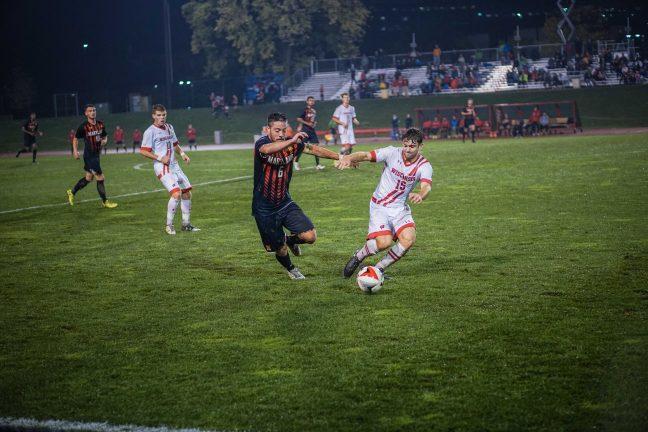The Wisconsin men’s soccer team is playing well through the first nine games of their 18-game regular season schedule.
To their credit, they did not get off to a fast start in 2018 either. Yet, by the end of that regular season they were able to take down top Big Ten talent such as Michigan and The Ohio State University.
The ultimate cause to a slow start to this season was a faulty offense that couldn’t seem to score a meaningful goal to save its life. What was once a nagging problem holding back an otherwise talented team is now a systemic issue.
Through nine games, the Badgers have scored a whopping five goals in total. Four of these five goals came during the Badgers’ only two wins of the season against University of Alabama-Birmingham and Lehigh.
That leaves just one other goal throughout the rest of the season. This is no longer the start of the season — the Badgers are now over halfway through the regular season. Despite an ample number of games at their disposal, they have scored just one goal outside their two wins, one of which was against a UAB team that is struggling mightily in a conference significantly less competitive than the Big Ten.
Let’s dive into exactly why the Badgers are currently unable to put up steady production in the opposing half of the field.
In 2018, the team managed 1.33 goals per game off an impressive 11.4 shots per game. This year’s stats amount to less than half of those numbers. They are currently averaging a measly 0.56 goals per game with just 6.4 total shots per game in 2019.
It doesn’t matter how many miracle performances goalkeeper Dean Cowdroy is able to put out, of which there have been multiple — with such low production coming out of the attack, the Badgers won’t be able to secure any sort of consistency.
Cowdroy currently has a goal-against average of 1.30 compared to just .988 in 2018, despite having a save percentage practically equal to his 2018 average. This means that he is saving roughly the same percentage of shots taken against him but the opposing team is scoring more goals nonetheless.
Part of this unfavorable reality may be due to lacking performances from their defensive unit, but an undeniably key factor is that the Badger attack simply hasn’t been able to keep the ball in their opponents’ half in order to get quality shots off.
Including post-season games played in the Big Ten championships in 2018, the Badgers played 18 games in total. In 2019, they are currently 6-2-1, meaning that they’ve played exactly half of their total games played in 2018.
Especially for a team that is returning key players in the attacking zone, including sophomore forwards Andrew Akindele and Noah Melick as well as senior midfielder Noah Leibold, one would expect that their shot totals would be equal to around one half of their total numbers from 2018.
With 205 total shots had in 2018, that number would be just barely over 100 shots through 9 games. Instead, the Badgers have fired off a grand total of 58 shots in all of 2019. This total is barely over one quarter of what they managed last season.
But the problem is not just with the quantity of shots, it’s the quality too. Last year’s squad put 42% of their shots on target. This year, that number has fallen down to 34.5%.
These two stats constitute the crux of the problem for the Badgers this year. Even with just a measly 58 shots taken, that number is padded by the fact that many of those shots are of lower quality than those taken last year.
It’s tough to find much of a reason for why such a dramatic shift in output took place in a season that saw the Badgers return much of their talent. Looking through their stat sheets, it is becoming harder and harder to refute the possibility that last year’s hot streak in the back half of their season was a fluke.
If the Badgers can’t turn around their season at this point, it’s quite tough to believe that this nine-game stretch has been simply some sort of extended slump. Each and every shutout loss, of which there have already been five, adds to the narrative that the Badgers have a systemic problem in their current program.
Their competition against reigning national champion Maryland was the first sign of some spark from this team all season. Yet, even that game saw the Badgers score zero goals as they tied Maryland 0–0 after double overtime.
Time still remains for the Badgers to pull together a decent season, but just how they will get past their current offensive struggles remains to be seen. One thing remains certain, if no significant changes are made, they will continue down their current path of underperformance.


